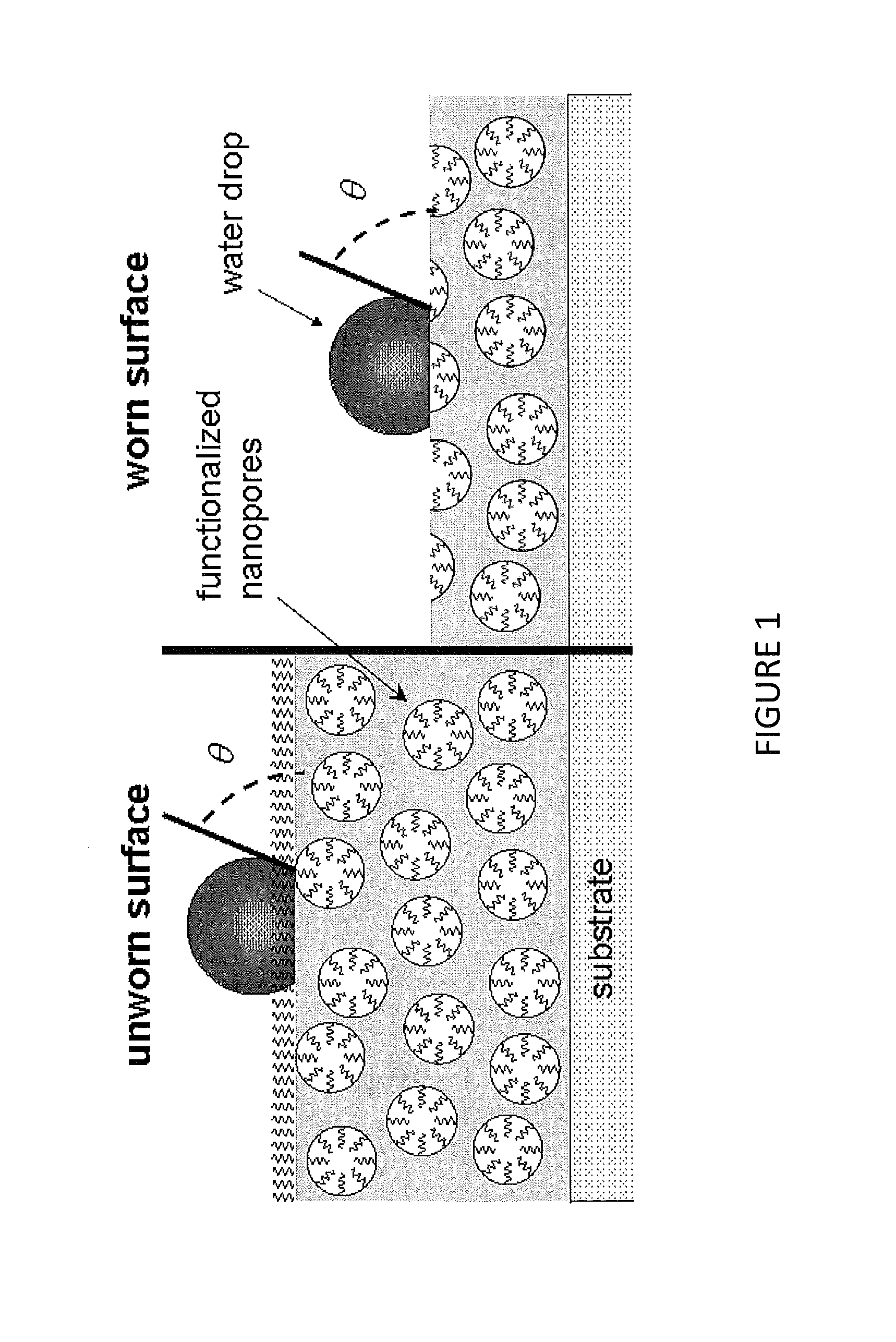Hydrophobic and oleophobic coatings
- Summary
- Abstract
- Description
- Claims
- Application Information
AI Technical Summary
Benefits of technology
Problems solved by technology
Method used
Image
Examples
example 1
Preparation of Coatings
[0071]Fluorinated silica films were synthesized at room temperature via co-condensation of fluorinated silane with an alkoxide silica precursor in the presence of a surfactant. Tetraethoxysilane (TEOS, Acros Organics) was used as the alkoxide. A perfluoropolyether silane (FPES, Fluorolink S10, Solvay Solexis) was used for functionalization in order to present the best possible surface for non-wetting properties. Fluorolink S10, which has the structure shown below, was selected for this study because it has a fairly large molecular weight (average=1850 g / mol) compared to perfluoroalkylsilanes and two silane grafting end groups. Longer functional molecules have been shown to increase the hydropobic / oleophobic character of films, and two grafted ends increases resistance to mechanical removal from the matrix. Additionally, interchain hydrogen bonding between amide moieties has been found to enhance intermolecular stability. Pluronic F127 (MW=12600, PEO106PPO70PEO...
example 2
Characterization Techniques
[0073]Films were abraded using a lab-built reciprocating polishing wear apparatus. The details of the instrument are available elsewhere (See, Kessman, A.; Huckaby, D.; Snyder, C.; Kukureka, S.; Cairns, D. Wear 2009, 267, 614-618). Briefly, this instrument uses a vertically-loaded, conformal polishing surface to uniformly and gradually wear through the surface of a film of thickness on the order of several hundred nanometers. The polishing media, composed of an aqueous slurry of 0.3 □m alumina particles (90-187120, Allied), is trapped in a cloth pad (90-150-285, Allied). The pad is in contact with the surface over a nominal area of 175 mm2, and a 4.70 N normal force is applied while the pad reciprocates over a stroke length of 35 mm at 0.1 Hz. These conditions were chosen to represent conditions similar to that of a finger touching an electronic sensor or manual cleaning of devices like solar panels. Samples were periodically removed for analysis, before w...
example 3
Chemical Properties of Coatings
[0079]All unworn films (synthesized in Ex. 1) had contact angles in the range of 105-110° for water and 63-67° for n-hexadecane, with standard deviations of <2°. The contact angles on unworn surface were independent of FPES concentration, which is often the case provided that the concentration of the hydrophobic moiety exceeds a minimum threshold. After a small number of wear cycles (sliding distance<20 m), the contact angles (CA) decreased, eventually fluctuating around some average value, reported here as the bulk contact angle. Although we describe the surface characteristics in more detail in the later section on tribological properties, we should mention here that the coatings were all relatively smooth (Ra<50 nm) both before and after polishing wear, and so the contact angle measurements can be considered unaffected by surface roughness effects.
[0080]FIG. 2A shows a sample plot of CA versus sliding distance for films synthesized with xf=0.04 and ...
PUM
| Property | Measurement | Unit |
|---|---|---|
| Temperature | aaaaa | aaaaa |
| Temperature | aaaaa | aaaaa |
| Fraction | aaaaa | aaaaa |
Abstract
Description
Claims
Application Information
 Login to View More
Login to View More - R&D
- Intellectual Property
- Life Sciences
- Materials
- Tech Scout
- Unparalleled Data Quality
- Higher Quality Content
- 60% Fewer Hallucinations
Browse by: Latest US Patents, China's latest patents, Technical Efficacy Thesaurus, Application Domain, Technology Topic, Popular Technical Reports.
© 2025 PatSnap. All rights reserved.Legal|Privacy policy|Modern Slavery Act Transparency Statement|Sitemap|About US| Contact US: help@patsnap.com



